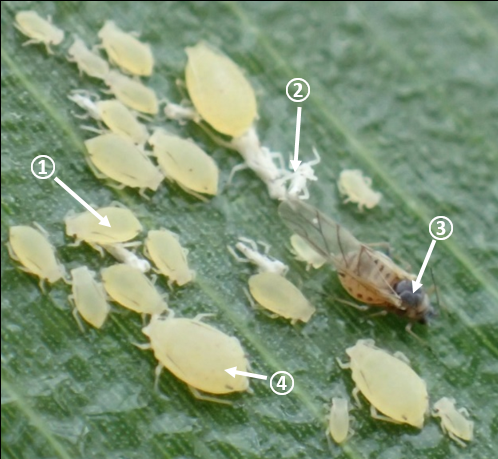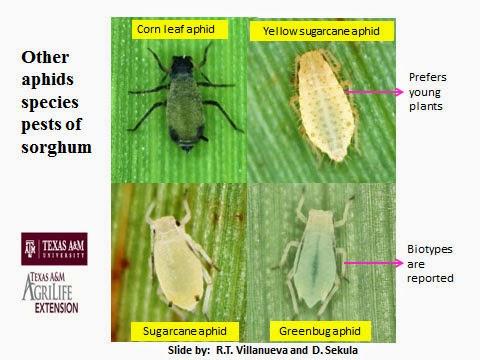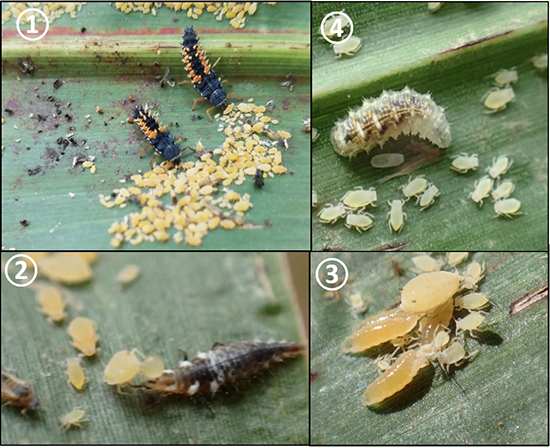The Sugarcane Aphid, a Significant New Insect Pest of Sweet Sorghum in Kentucky
ENTFACT-157: The Sugarcane Aphid, a Significant New Insect Pest of Sweet Sorghum in Kentucky | Download PDF
Nathan Mercer, Laboratory Technician
University of Kentucky College of Agriculture, Food and Environment
Biology and Background to Pest Status on Sweet Sorghum
The sugarcane aphid (SCA), Melanaphis sacchari (Hemiptera: Aphididae), has been present in the United States since the 1980’s, as a very minor pest on sugarcane in the southern United States. However, a new strain of SCA, likely originating in Asia or Africa, was found infesting sorghum fields in the southern United States in 2013. The SCA was first detected infesting sweet sorghum in Kentucky in 2015, and has been reported on sweet sorghum in subsequent years. Kentucky has the highest acreage of sweet sorghum in the United States; over 2,000 acres are planted annually producing $16-27 million of sweet sorghum. The sugarcane aphid poses a significant threat to this important agricultural commodity in Kentucky.
In addition to infesting sweet sorghum, SCA feeds on grain and forage sorghum, hybrids of sudangrass and Johnson grass in Kentucky. SCA migrates north from overwintering regions in southern Texas and northern Mexico to re-colonize Kentucky each year. To survive the winter SCA must have a green (live) host plant to feed on. No suitable host stays green outside during winter in Kentucky, therefore SCA cannot survive Kentucky winters outdoors. SCA in the US are all female, reproducing asexually (producing clones). Each adult female can produce 96 nymphs (young aphids) over 2-5 weeks resulting in large infestations of SCA on a single leaf (Figure 1).

Figure 1. Over a thousand sugarcane aphids on a sweet sorghum leaf, counted by estimation.
Damage
Large infestations of SCA in sweet sorghum can cause serious damage, and in some cases result in complete crop loss if left untreated. Damage to sweet sorghum results in loss of yield, growers have reported harvesting one quarter of expected yields from fields under heavy infestation. SCA infestations often start on the lower leaves of a plant, but as the season progresses will be found on higher leaves and the seed head. SCA is not known to transmit any plant pathogens that damage sweet sorghum.
SCA can damage sweet sorghum production in three ways. First, loss of plant sap by feeding aphids weakens and can kill sweet sorghum plants. Secondly, plant health can be reduced by sooty mold build up which grows on the liquid waste (honeydew) produced by SCA. Sooty mold coats leaves and blocks photosynthesis. Third, infestations in sweet sorghum can reduce the sugar content of juice and alter the syrup flavor.
Identification
SCA have a yellow to pale yellow body and black antennae, feet (tarsi) and tail-pipes (cornicles). Winged forms of SCA are brown to dark yellow (Figure 2). In Kentucky, three other species of aphids can commonly be found colonizing sweet sorghum: corn leaf aphid, greenbug and yellow sugarcane aphid (Figure 3). Both the corn leaf aphid and greenbug can be easily distinguished from SCA by their green color. Corn leaf aphid is normally found in the whorl of sorghum, while SCA is normally on lower to mid-plant leaves until late in infestations. The yellow sugarcane aphid adults have rows of yellow spines along their body. Only SCA reaches damaging levels on sweet sorghum in Kentucky.

Figure 2. Sugarcane aphid, (1) nymphs, (2) shed skin, (3) winged adult, (4) wingless adults.
General: An important first step in the management of SCA is to manage alternate hosts, such as Johnson grass, and volunteer sorghum. Management of alternate hosts should especially be done in structures that are heated during the winter, e.g., greenhouses. Winter temperatures in Kentucky are lethal to SCA, but structures such as greenhouses can provide SCA winter shelter and allow them to infest fields early in the spring. A second management tactic is to reduce the time sorghum is exposed to damaging levels of SCA, by planting as early in the growing season as possible. While planting just after the threat of spring frost would be ideal to avoid SCA, sweet sorghum seeds need warm soil to germinate. Soil temperature at a depth of 2 inches should be 65°F for direct seeded sorghum. Some producers transplant their sweet sorghum. This management practice allows for earlier crop development as seeds are started earlier plus the recommended soil temperature for transplanting is 60°F. Later maturing varieties perform better in the transplant system than earlier maturing varieties www2.ca.uky.edu/agcomm/pubs/agr/agr122/agr122.pdf). The length of time the sweet sorghum crop is exposed to SCA could also be reduced by growing an earlier maturing variety, although early maturing varieties generally grow to a shorter height and yield less than later maturing varieties.

Figure 3. Four species of aphids that can infest sweet sorghum.
Scouting: Weekly scouting for SCA should begin in the first week of June. Scouting involves inspecting eight sets of five sorghum plants in a field. On each plant, the underside of one leaf between knee and chest height should be checked for SCA. After SCA has been detected in a field, scouting should be increased to twice a week. A single plant is defined as infested if 40 or more SCA are found on the searched leaf. The action threshold for chemical insecticide application is when 25% or more of plants searched are infested. This action threshold is based on economic thresholds for grain and forage sorghum. Timely application of pesticides once action thresholds are reached will prevent SCA from reaching damaging population levels. After chemical applications scouting should continue for SCA as populations may increase again.
MyFields (https://www.myfields.info/pests/sugarcane-aphid) has maps of where SCA has been reported in the US in the current and previous years and provides links to other SCA information. Preventive insecticide sprays below the threshold are not recommended. SCA infestations often do not reach damaging levels and do not need treatment. SCA are preyed upon by numerous insects which would also be reduced by pesticide sprays (Figure 4). To conserve these natural enemies and save time and money it is important to use a threshold to determine when to spray your crop.

Figure 4. Sugarcane aphids being eaten by 1) lady beetle larvae, 2) lacewing larva, 3) aphid midge larvae, 4) hover fly larva.
Chemical Management: The only labeled insecticide for aphid management in sweet sorghum is insecticidal soap. Rates for insecticidal soaps can vary; read the label for specific application requirements. Insecticidal soaps are only effective when wet and should be applied in late afternoon or evening to maximize the period the soap is active. In the past, EPA has granted Kentucky a Section 18 emergency exception to allow use of certain insecticides for management of SCA. Section 18 exemptions are granted to states on a year by year basis. Please check with you county extension agent to see if the Section 18 has been granted for the current year. Sivanto Prime can only be applied to sweet sorghum under this exemption. Please contact your county agent to see if one has been granted for the current year. If a Section 18 is granted, the applicator must have a copy of the Section 18 label, be a certified pesticide applicator (private or commercial) and report acreage and volume sprayed to the Kentucky Department of Agriculture (502.573.0282 or agweb@ky.gov). This reporting aids Kentucky in obtaining the emergency exemption from the EPA in the future.
Issued: 7/19
CAUTION! Pesticide recommendations in this publication are registered for use in Kentucky, USA ONLY! The use of some products may not be legal in your state or country. Please check with your local county agent or regulatory official before using any pesticide mentioned in this publication.
Of course, ALWAYS READ AND FOLLOW LABEL DIRECTIONS FOR SAFE USE OF ANY PESTICIDE!
Images: University of Kentucky Entomology
